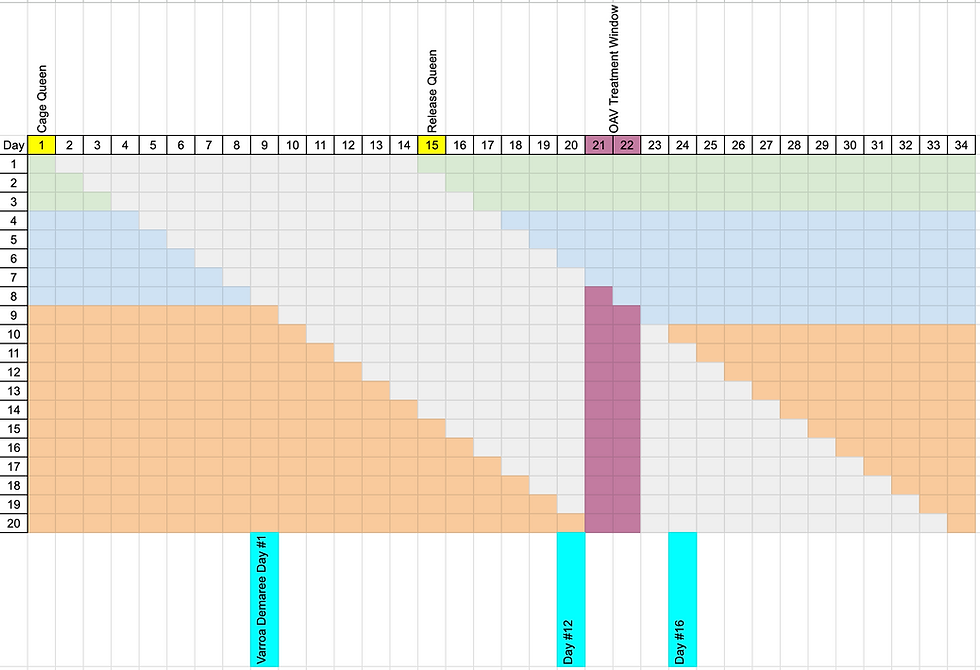Need help managing Varroa in QLD?
- Keith Barton
- May 13
- 3 min read
Updated: May 13
If:
You're a QLD beekeeper.
Your hives have varroa mite.
You don't quite know what to do or who can help you.

Where do I find help that I can trust?
Your local club can provide help, but if there is no local club, then contact varroa@daf.qld.gov.au to get in touch with a Varroa Development Officer (VDO). VDOs are an extension and training resource funded by the National Varroa Mite Management Program (NVMMP). VDOs are beekeepers just like you, and have a significant breadth of knowledge in Integrated Pest Management for varroa mite. VDOs provide free consultations to beekeepers to help them prepare for varroa mite management as it spreads into Queensland.
Full disclosure - I am a VDO (until August 2025)
As an experienced beekeeper and current VDO, I am available to provide an assessment of your hive health and varroa mite loads, and can provide advice on options to help manage varroa and how to adapt your management practices for varroa IPM. I can train you on monitoring and management best practice. You will need to know this stuff to keep healthy bees when varroa turns up in your hives.
Help is just an email/phone call away.
Not managing varroa mite is not an option
Sadly, all Australian hives will eventually be infested by some level of varroa mite as it becomes endemic across the country. Spread may be slow, but it is inevitable.
The only way to know your hive has varroa is to test for presence. This can be done using an alcohol wash of 300 brood bees (nurse bees), uncapping 100-200 drone cells, or inspecting the bottom board for fallen/dead mites. In low infestations, drone uncapping is probably the most sensitive test for presence. Unfortunately, hives do not always have enough capped drone brood.
The gold standard test is the alcohol wash. Collect half a cup of nurse bees from the brood box and wash in methylated spirits in a vessel that allows mites to separate from bees. Shake vigorously for 15-30 seconds, inspect the solution for fallen mites. Repeat this shake-and-look process 2 more times with the same sample of bees to be sure all mites have dropped off the bees.
If you have mites, then the mite "load" or infestation level in the hive can be determined as a percentage: ((number of mites)/300)x100 = percentage. For example:
Wash contains 6 mites
(6 / 300) x 100 = 2%
The infestation level is used to determine whether you have met or exceeded the threshold for treatment. "Threshold" is a concept of when the level of mite infestation is high enough to lead to more harm than the colony can withstand. Above the threshold level, the impact of mites on the colony will become progressively worse until the colony absconds or collapses and dies. Without treatment of some kind, the mite population will not return below the threshold.
For hot season (ie the Spring build-up through to mid-Autumn here in SE QLD) the threshold is 9 or more mites (ie 3%).
For cool season (ie the late-Autumn through to mid-July here in SE QLD) the threshold is 5 or more mites (ie 1.67%).
Above those threshold numbers a treatment is recommended.
Unmanaged colonies will die
It is clear that in the presence of varroa mite, unmanaged colonies don't stand much of a chance.
Based on experiences in other countries, 95% or more of our feral / unmanaged colonies will die within months of becoming infested. As they dwindle and die, these colonies will become super-spreaders known as "mite bombs", spreading mites into all surrounding hives within flight range (~2km).
A very rare colony may survive, and this "survivor stock" may represent good genetics for future varroa resistance. However, in the short term, few beekeepers would be happy to lose 95% or more of their colonies.





Comments